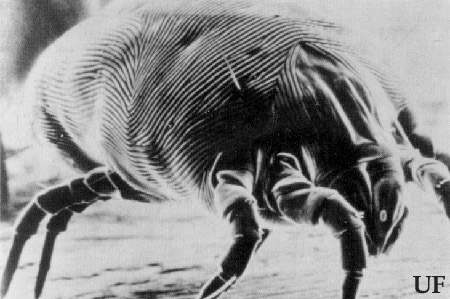According to the Asthma and Allergy Foundation of America, “each day 11 Americans die from asthma. There are more than 4,000 deaths due to asthma each year, many of which are avoidable with proper treatment and care. In addition, asthma is indicated as “contributing factor” for nearly 7,000 other deaths each year.”

House dust mites can cause allergic reactions and onset of asthma symptoms. Photo taken by G.W. Wharton. Photo credit: University of Florida Institute of Food and Agricultural Sciences.
Recently, a major breakthrough in asthma research has heralded a new era of focus and direction for asthma treatment and study. It is general knowledge that household dust mites are a major source of allergens and may cause onset and exacerbation of asthma and asthma symptoms, but little was known about why mites can cause such severe allergic reactions. Research conducted by Dr. Christopher Karp, head of the Division of Molecular Immunology at Cincinnati Children’s Hospital Medical Center and colleagues have shed light upon this mire. For the 1 in 13 Americans that suffer from asthma, as well as the additional millions world-wide, this is good news indeed.
Karp’s research, published December 7th in the online edition of Nature, reveals that exposure to dust mites causes the immune system to mistake them for a bacterial infection and as a response, launches a heavy humoral attack on the supposed bacterial invaders, causing severe allergic reactions and triggering asthma symptoms.
The study demonstrated that certain common dust mite proteins can trigger severe allergic reactions and consequently the onset of asthma symptoms. They found that the mite protein (Der p 2) functions similar to another protein (MD-2) which acts as part of a receptor signaling complex. The body, mistaking exposure to mite protein Der p 2 as signals from MD-2, acts accordingly and launches the first defense against bacterial infections, to initiate allergic reactions to flush out the bacteria.
Karp’s study was funded by the American Asthma Foundation’s Strategic Program for Asthma Research (SPAR) which is dedicated to sponsoring asthma research in hopes for improving asthma treatment.
Now armed with the knowledge of how and why the body reacts to a common outside protein clarifies how dust mites can cause such severe reactions and can serve to develop a better treatment model to combat both allergies and asthma.
References:
Allergenicity resulting from functional mimicry of a Toll-like receptor complex protein. Aurelien Trompette, Senad Divanovic, Alberto Visintin, Carine Blanchard, Rashmi S. Hegde,Rajat Madan, Peter S. Thorne, Marsha Wills-Karp, Theresa L. Gioannini, Jerry P. Weiss&Christopher L. Karp. Nature, doi:10.1038/nature07548; Published online 7 December 2008
American Asthma Foundation
Asthma and Allergy Foundation of America





Comments